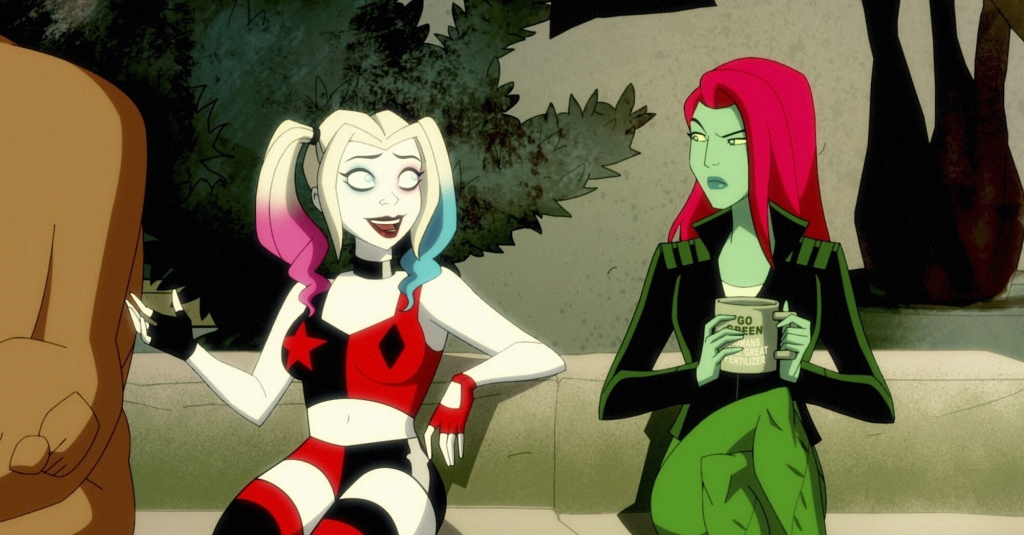Harley Quinn’s new animated show arrived with all the chaotic energy of Harleen Quinzel herself, full of stunts, hyper stylised violence and more curse words per square inch than a sailor who just caught himself in his zipper. It’s managed to capture Harley’s frenetic personality and channel that into its momentum, with Season 2 premiering just seven weeks after Season 1 concluded. Perhaps the most Harley thing it has done so far though has been the way it’s taken big, outlandish risks and had pretty much all of them pay off.
The series begins with a face off between Batman and Joker, with Harley seen by both DC icons as a distraction to the main event, just as she has been for her entire existence. Batman: The Animated Series gave her significant focus but almost always as the Joker’s forlorn lover, the Arkham games offer decent spotlight but, again, as an accessory to Joker, and even the Suicide Squad movie – despite being built around Margot Robbie’s Harley – framed her as a part of Joker’s mythology first, her own person second.
She’s had her own solo stories in the comics, sure, but these days, it’s what you do outside of the comics which really makes you a somebody. This show – beating Birds Of Prey to the punch by a couple of months – was the first to truly explore Harley Quinn as a person. Batman and the Joker both feature in the series, but have inconsistent supporting roles (the very kind Harley herself is used to) in the first season and are absent for large chunks of the second. To avoid spoilers, we’ll say no more details on how or why.

Building a show around Harley herself is a risk. An educated one, maybe, given her rapid surge in popularity, but a risk nonetheless. She’s a villain, one without a track record as a solo star and as a female character, her place as the leading light in a comic book story is immediately put under scrutiny, however unfair that may be.
As is typical of Harley though, the show pulls no punches. Not only does it give Harley her starring role, it gives her a crew made up of Psycho, Clayface and King Shark, with the level headed Poison Ivy the only stellar name alongside Harley herself. The presence of Joker, Batman, but also Bane, Two-Face, Mr Freeze, Riddler, Aquaman, Wonder Woman (this list could go on and on) suggests that the producers weren’t limited when it came to selecting characters, but deliberately opted to go for lesser names. Part of that might be to avoid overshadowing Harley, but with Kaley Cucoco dialling it up to eleven and hyper intense action sequences in every episode, there was little chance of any of that anyway.
No, it’s much more likely that the producers knew, despite the risk, that b-listers offered a greater scope for creativity, more room for them to reinvent characters and played into the themes of the show that go hand in hand with elevating a perennial supporting star like Harley. We’ve seen the big names done to death: nobody picks up Mario Kart to play as Mario.

These characters are nobody’s favourites, but the show has been able to build them up into something much more interesting than a pedestrian appearance from a marquee name. The show has built each character superbly, essentially creating new personas from the pre-existing, flimsy background cast members they once were.
Clayface is especially genius, taking his transformation power to new heights with a overdramatic thespian Clayface emerging. Shark King is one of the more malleable DC characters, with various different versions of him create over the years, but Harley Quinn’s, a slightly dull witted, pencil pusher who is prone to bouts of rage, is one of the most unique.

It’s not just selecting the characters which shows a wildcard kind of bravery either. It’s the way they use them, especially the bigger guns. Bane is now a doofus, the butt of every joke in the Legion Of Doom, whose motivations for his every evil deed are both petty and ridiculous. It’s a million miles away from Bane’s characterisation, yet it also feels exactly like him.
By focussing on DC’s lesser lights and giving a fresh new flavour to already established ones, Harley Quinn shows the DCEU the light. Through the likes of Guardians Of The Galaxy, Black Panther and Thor: Ragnarok, the MCU has been reinventing and taking risks for years. The DCEU conversely seems more bogged down, only really letting their lower budget features – Shazam! and Birds Of Prey – try something less formulaic.
At times the formula has worked (Wonder Woman) and at times it’s failed (Justice League), but it’s hard to get truly invested in the DCEU while it’s constantly playing safe.

Harley Quinn though grabs you by the shoulders and smashes its forehead into yours from the off. There’s a ballet of violence and a commitment to Harley’s foul mouth and penchant for destruction that’s difficult not be taken in by, but it’s also in the ways they’ve constructed this world as the perfect playground for the Maiden of Mischief.
The show is vintage Harley, but it’s a vintage that’s been accessorised with gloriously mismatched jewellery and all been combined into an outfit both modern and daring. Established characters, patterns, settings and themes of Gotham are all filtered through Harley’s chaotic lens into something new, something bright, brave and bold.
Everything about this show is a risk. And pretty much everything pays off.

